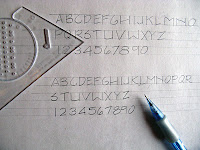
Every few years I get disgusted with the lack of style and legibility of my handwriting. This is a cycle that has been repeated for well over half a century now. You would think I might have been able to avoid this, given that my early school years were in an era in which handwriting instruction was taken seriously. My teachers demonstrated proper letter forms on the (black) blackboard, and I tried to follow along after dipping my steel-nib pen in a bottle of ink on my wooden desk. It just never took.
The last time I tried to repair my handwriting performance was during one of those periodic appearances of interest in calligraphy. It was kind of fun, but my production never showed much style. I don't expect to achieve great artistry this time around, either, but I think I have a better chance of useful self-improvement because I've chosen to focus on the simple lettering style favored by modern draftsmen and architects.
What got me started was a posting at the Design Observer blog, which led to a great little instructional video at Doug Patt's How to Architect blog. Doug brings a lot of experience and sophistication to a simple lettering style, and his brief demo is really inspiring.
I decided I should really start with something more fundamental than Doug Patt's example, so I googled around until I found JoBeth Halpin's Architectural Drafting Fundamentals at the Triton College web site. That proved to be exactly what I was looking for. The step-by-step presentation and the interactive exercises are wonderfully designed for the beginning draftsman. The next morning, I went to two art materials stores and picked up the necessary tools including a drawing board, pencils and an Ames Lettering Guide. I have to confess those nifty little plastic gizmos are a big part of the attraction for me of this type of undertaking. At this point, I've invested less than an hour in the project, but I'm encouraged by hints of progress already.
This activity has also been a nice excuse for me to look more closely at the extraordinary learning opportunities available through the web. I've generally avoided on line video up to this point, but the power of the medium is really seductive, and I feel myself moving toward it quickly.
At the same time, I'm also pleased to get back to working on some purely manual skills. Computers are great, but they can create a false sense of competency; it becomes difficult to distinguish your own real skills from what the computer is mostly doing behind the scenes. This also applies to the field of photography, and partly explains why I prefer to work with film and old, manual cameras.
I agree with your point about working on manual skills, it does help you feel connected to reality, sort of like an unplugged version. I pick up the guitar when I feel the need for connecting on this level. Being left handed any attempt to improve my handwriting skills is futile .I even had my drafting teacher in high school suggest I try to become right handed. Bless his heart - :)
ReplyDelete